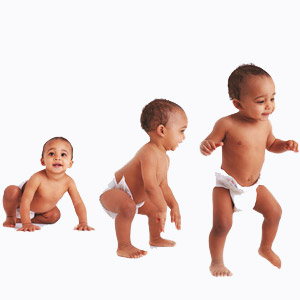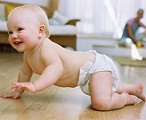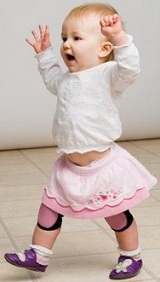 Whilst babies often learn to walk on their own eventually, there are ways that you can gently help them towards this developmental milestone. Babies may sometimes need a little encouragement to get moving and it’s true that many children will not begin to walk unless they have appropriate opportunities and support. There are a few tips on how to help baby walk.
Whilst babies often learn to walk on their own eventually, there are ways that you can gently help them towards this developmental milestone. Babies may sometimes need a little encouragement to get moving and it’s true that many children will not begin to walk unless they have appropriate opportunities and support. There are a few tips on how to help baby walk.
When Will My Baby Start Walking?
It is important not to expect too much from your little one as walking is a milestone that babies approach at different speeds and at different ages. There are lots of changes and muscle development that needs to happen before your bub can start walking unaided. Rolling, sitting, crawling and standing are all achievements on the path to walking. Standing or pulling themselves up on furniture can happen anytime from 6 to 10 months and is a tentative signal from your child that they are ready to start getting mobile, but it can take some time to make the progression from this stage to walking. Your baby may start walking unaided at about 15 months, but this requires mastering the nuances of balance and limb coordination which may take children up to 17 months of age.
How to Help Baby Walk
It is so easy to get carried away with caring for this tiny little person and not allow them to do anything for themselves. Fostering independent movement is important for your child and involves encouragement as well as the patience to achieve the goal. There is a vast amount of development that has to occur in a relatively short space of time. You child goes from being immobile earlier than 4 months to being an independently mobile little human after 15 months. This exciting developmental time for your bub happens in the following stages:
|
Stages |
What Babies Can Do |
How to Help Baby Walk |
|
4-7 months
|
Your baby is able to sit on her own and balance their feet on your legs when held, allowing him to bounce up and down. |
Limit door bouncer use to three 15 minute-sessions a day or play stacking games to enhance her muscles. |
|
7-10 months
|
Your baby will begin to crawl as well as bend his knees and lower himself to sitting from 9 to 10 months. |
Help your baby to practice moving arms and legs together by encouraging him to crawl often. If your baby gets stuck and cries for assistance when trying to sit after standing, don’t just sit him straight down, but show him how to safely bend his knees and sit down without losing his balance and falling over. |
|
8 months |
Your baby is starting to pull himself up on furniture, people and anything he can get hands on to standing. |
Encourage your child to step away from the object they are leaning by kneeling in front of them and encouraging them to take a step or move towards you. |
|
8-9 months
|
You baby is showing the interest and ability to walk with assistance. He is still very reliant on your help. |
Keep bub moving and practicing. This is the key to helping your bub to progress. Give your baby some stable toys with wide base of support to hold on to and push. |
|
9 -12 months
|
Your baby is starting to show early developmental signs of beginning to walkindependently or capable of holding your hands to walk. Sitting, standing, squatting and balancing is becoming more fluid and happen with very little to no help and to her first steps. |
Try balancing game to see how long your baby can stand. Keep your baby’s feet as free as possible or ensure that all shoes and sock are not too tight fitting or slippery. Letting him go barefoot will help him to develop balance and coordination. Slowing guide your baby to her first steps by first sitting her on the floor then let her walk independently when she gains her balance. |
|
12-15 months
|
Your baby may be walking, however unsteadily, without assistance. He can move freely and is beginning to gain confidence and speed. |
Toddler proof your home and make sure that your child has a safe space to practice walking. Clear floors will encourage him to practice his skills often. Remember not to leave your child alone just in case he falls or injures himself. |
Tips to Remember
- Avoid walkers- Toddler and baby walkers, despite their name and claims, can actually hamper independent movement by making your child less concerned with developing their own balance and coordination. Walkers are nowhere near as effective as allowing your child to strive for their own independent motion. It is recommended to avoid a walker to speed up your child’s development.
- Try a jumper– It is important to stay right next to your baby when she’s in a bouncer or jumper. Jumpers can encourage babies to stretch their legs properly and develop muscle strength. As with all equipment for babies, it is important to buy a product that follows safety guidelines. Be sure to check with the retailer and do your research into what jumpers are recommended from a safety perspective. Helpful as they might be, jumpers should not be used for long periods of time as overuse of jumpers can delay mobility. In most cases, babies’ motor skills are developed under conditions where they have the opportunities to use their muscles without any assistance.





